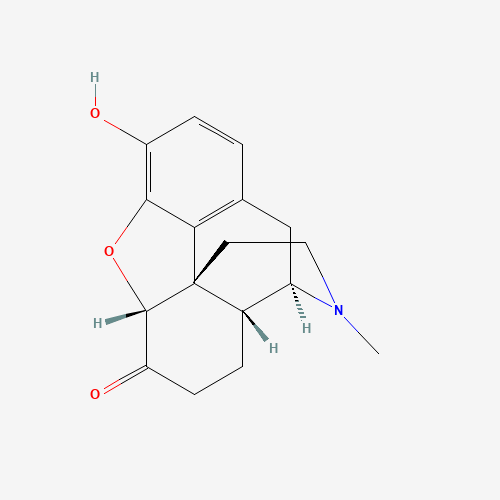| Pharmaceutical Information |
| Drug Name |
Hydromorphone |
| Drug ID |
BADD_D01096 |
| Description |
Hydromorphone is a pure opioid,[A176468] a semi-synthetic hydrogenated ketone derivative of [morphine] that has been available clinically since 1920. Structurally, hydromorphone derived from [morphine] in the modification of the hydroxyl group in the carbon 6 to a carbonyl and the absence of a double bond between the carbon 7 and 8. Due to these modifications, it presents a very high potency and comparable side effect profile to the parent compound.[A176471] Even though hydromorphone does not present a 6-hydroxyl group, it is categorized under the family of phenanthrenes and it is considered a chemical under the schedule II (medical purposes with high addiction potential).[A176495]
The first reported approved product containing hydromorphone in the form of hydromorphone hydrochloride was developed by Fresenius Kabi USA and FDA approved in 1984.[L5795] |
| Indications and Usage |
Hydromorphone is indicated for the management of moderate to severe acute pain and severe chronic pain. Due to its addictive potential and overdose risk, hydromorphone is only prescribed when other first-line treatments have failed.[A176468]
The WHO has proposed a three-step ladder for the management of pain in which it is suggested to start with a non-opioid medication followed by addition of weak opioids to the non-opioid treatment for moderate pain and finishing in the use of strong opioids such as hydromorphone along with the existing regimen for cases of severe pain.[A176471]
Off-label, hydromorphone can be administered for the suppression of refractory cough.[A176468] |
| Marketing Status |
approved; illicit |
| ATC Code |
N02AA03 |
| DrugBank ID |
DB00327
|
| KEGG ID |
D08047
|
| MeSH ID |
D004091
|
| PubChem ID |
5284570
|
| TTD Drug ID |
D04JHN
|
| NDC Product Code |
Not Available |
| UNII |
Q812464R06
|
| Synonyms |
Hydromorphone | Dihydromorphinone | Hydromorphon | Palladone | Laudacon | Dilaudid | Hydromorphone Hydrochloride |
|
| Chemical Information |
| Molecular Formula |
C17H19NO3 |
| CAS Registry Number |
466-99-9 |
| SMILES |
CN1CCC23C4C1CC5=C2C(=C(C=C5)O)OC3C(=O)CC4 |
| Chemical Structure |

|
|
| ADRs Induced by Drug |
|
|
*The priority for ADR severity classification is based on FAERS assessment, followed by the most severe level in CTCAE rating. If neither is available, it will be displayed as 'Not available'.
**The 'Not Available' level is hidden by default and can be restored by clicking on the legend twice.
|
|
|

